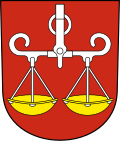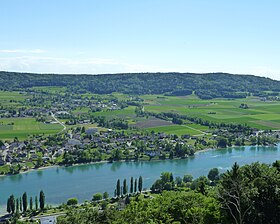Wagenhausen TG
| TG is the abbreviation for the canton of Thurgau in Switzerland and is used to avoid confusion with other entries of the name Wagenhausen . |
| Wagenhausen | |
|---|---|
| Country: |
|
| Canton : | Thurgau (TG) |
| District : | Frauenfeld |
| Postal code : | 8259 |
| BFS no. : | 4871 (Political Community) |
| former BFS no .: | 4873 (local parish ) |
| Coordinates : | 705906 / 279728 |
| Height : | 403 m above sea level M. |
| Area : | 11.82 km² (Polish municipality) 2.90 km² (local municipality) |
| Residents: | 1694 (December 31, 2018) |
| Population density : | 150 inhabitants per km² |
| Website: | www.www.wagenhausen.ch |
|
Wagenhausen |
|
| map | |
Wagenhausen is a village and a municipality in the Frauenfeld district in the canton of Thurgau in Switzerland .
The municipality of Wagenhausen in the Steckborn district, established in 1803, comprised the villages of Kaltenbach , Rheinklingen and Wagenhausen. In 1838 the local communities Kaltenbach, Rheinklingen and Wagenhausen were formed within this municipal community . On June 1, 1995 , the municipality of Wagenhausen merged with its three local communities to form the political municipality of Wagenhausen, which has been part of the Frauenfeld district since 2011.
geography
Wagenhausen is located on the left bank of the High Rhine, southwest of Stein am Rhein on the road to Schaffhausen . The political municipality consists of the four localities Wagenhausen, Kaltenbach , Etzwilen and Rheinklingen .
history
The oldest of the numerous sites in Wagenhausen go back to the Mesolithic . Wagenhusa was first mentioned in a document in 1083 . Since the Middle Ages , various noble families have held the lower court rule of Wagenhausen, including von Klingen from the 13th century to 1433 , from 1483 von Roggwil , 1561 von Fulach, 1563 von Breitenlandenberg and 1565 von Ulm , 1575 to 1798 the city Stein am Rhein and from 1593 to 1596 temporarily Michael von Schwarzach.
In 1083 Tuto donated his property to the Benedictine monastery of All Saints in Schaffhausen , on condition that monks (pauperes Christi) were to be entertained in Wagenhausen. Allerheiligen then built a monastery with a Romanesque pillar basilica . The early history of the monastery exemplifies the conflicts in the replacement of the self-owned monastery system by the Hirsau reform .
The monastery basilica, the north aisle of which was demolished around 1600, served as the Reformed church of Wagenhausen in the 21st century; of the rest of the monastery, only the east wing remains. After a dispute between Tuto and the Abbot of All Saints, Wagenhausen went to the Bishop of Constance , who from 1105 had it administered by the Abbot of Petershausen . After Tuto's death in 1119, Wagenhausen became its own abbey, which flourished under Abbot Lassen (1156) and consisted of around 25 monks and two to three nuns. In 1417 All Saints' Day incorporated the weak Wagenhausen as a provost's office . In 1524 the village took part in the Ittinger storm and in 1525 the provost converted to the Reformation . The city of Schaffhausen abolished the provost office in 1529, but rebuilt it in 1544, with the provost now acting as a reformed pastor. In 1861 the canton of Schaffhausen ceded the collature to the canton of Thurgau, which handed it over to the Reformed parish in 1862 . According to Eschenz, Catholics are parishes.
Wagenhausen had extensive forests with 250 Jucharten areas and a trot from 1548. In addition to arable, meadow and fruit growing, some viticulture was practiced and peat was cut. In Klingenriet and Wagenhausen there were four mills from the 14th century, which died at the end of the 19th century and 1917 respectively. Wagenhausen oriented itself economically to Stein am Rhein, with which it has grown together since the opening of the railway lines Etzwilen – Konstanz in 1875 and Etzwilen – Schaffhausen in 1895. During the boom, the number of new buildings increased from 1960 onwards, and the school was expanded in 1992.
→ See also the history sections in the articles Etzwilen , Kaltenbach TG and Rheinklingen
coat of arms
Blazon : in red a white scale with yellow bowls.
The Wagenhauser coat of arms is based on an old coat of arms that has been handed down on a church pane from 1570 in the parish hall in Unterstammheim . The cross contained in the local coat of arms was omitted. In 1998 the new political municipality decided to take over the coat of arms of the former municipality Wagenhausen.
population
 |
| 1831 | 1850 | 1900 | 1950 | 1990 | 2000 | 2010 | 2018 | |
|---|---|---|---|---|---|---|---|---|
| Political community | 1533 | 1619 | 1678 | |||||
| Municipal parish | 1328 | 1308 | 1052 | 1104 | 1418 | |||
| Local parish | 602 | 432 | 396 | 588 | ||||
| source | ||||||||
Of the total of 1678 inhabitants in the municipality of Wagenhausen in 2018, 350 or 20.9% were foreign nationals. 762 (45.4%) were Protestant Reformed and 275 (16.4%) were Roman Catholic. At that time, Wagenhausen had 623 residents.
economy
In 2016, Wagenhausen offered work to 260 people (converted to full-time positions). Of these, 17.6% were employed in agriculture and forestry, 41.0% in industry, trade and construction and 41.4% in the service sector.
Business
There is a shop with a Volg branch in the village center . There are also a few restaurants, a hairdressing salon and a little further down the Rhine a campsite including a restaurant.
traffic
Wagenhausen is on the main road Schaffhausen – Kreuzlingen . In public transport, access is via the Stein am Rhein train station on the lake line , which is only a few hundred meters from the Wagenhauser village center.
Attractions
The former Propstei Wagenhausen and today's Reformed parish church was built around 1085 and has hardly changed since then. It is one of the few originally preserved Romanesque churches in Eastern Switzerland. Another special feature of the Propstei is its bell, which was cast in 1291. It is one of the oldest still functioning bells in Switzerland.
In the vicinity of the Propstei there is also the 16th century Trotte, which was renovated in 1995. It is dated 1548 on the Kellerhals and is the oldest in the Canton of Thurgau.
The railway bridge on the Winterthur – Singen line , which was built in 1875 and has only been used as a museum railway since the Etzwilen – Singen section was closed, is an important historical monument .
Rheinklingen is listed in the inventory of places worth protecting in Switzerland .
Personalities
- Franz Anton Mesmer (1734–1815), inventor of “ animal magnetism ”, lived in Wagenhausen at the end of the 18th century
- Fritz Schär (1926–1997), racing cyclist
- Friedrich Vetterli (* 1822 in Wagenhausen; † 1882), technician, inventor
literature
- Alfons Raimann, Peter Erni: The art monuments of the Canton of Thurgau, Thurgau VI. The Steckborn district. (= Art Monuments of Switzerland. Volume 98). Edited by the Society for Swiss Art History GSK. Bern 2001, ISBN 3-906131-02-5 .
- Albert Knoepfli : Propstei Wagenhausen TG. (= Swiss Art Guide , No. 407). Ed. Society for Swiss Art History GSK. Bern 1987, ISBN 3-85782-407-7 .
Web links
Individual evidence
- ↑ a b Thurgau in figures 2019 . On the website of the Statistical Office of the Canton of Thurgau (PDF file; 1.8 MB), accessed on April 28, 2020.
- ↑ Swiss land use statistics. Completed on July 1, 1912. Published by the Federal Statistical Bureau. ( Memento from April 12, 2016 in the Internet Archive )
- ↑ Permanent and non-permanent resident population by year, canton, district, municipality, population type and gender (permanent resident population). In: bfs. admin.ch . Federal Statistical Office (FSO), August 31, 2019, accessed on December 22, 2019 .
- ↑ a b Localities and their resident population. Edition 2019 . On the website of the Statistical Office of the Canton of Thurgau (Excel table; 0.1 MB), accessed on April 28, 2020.
-
↑ a b c d e Erich Trösch: Wagenhausen. In: Historical Lexicon of Switzerland .
These sections are largely based on the entry in the Historical Lexicon of Switzerland (HLS), which, according to the HLS's usage information, is under the Creative Commons license - Attribution - Share under the same conditions 4.0 International (CC BY-SA 4.0). - ↑ a b municipal coat of arms . On the website of the State Archives of the Canton of Thurgau, accessed on December 8, 2019
- ↑ a b Population development of the municipalities. Canton Thurgau, 1850–2000 and resident population of the municipalities and change from the previous year. Canton of Thurgau, 1990–2018. On the website of the Statistical Office of the Canton of Thurgau (Excel tables; 0.1 MB each), accessed on April 28, 2020.
- ^ Albert Knoepfli : Propstei Wagenhausen TG. ( Swiss Art Guide , No. 407 Series 41). Ed. Society for Swiss Art History GSK, Bern 2000, ISBN 978-3-85782-407-4 .








